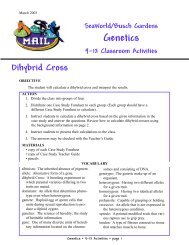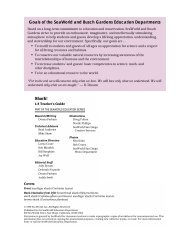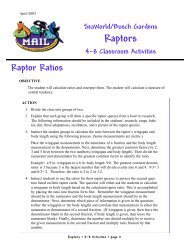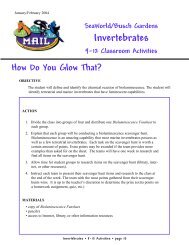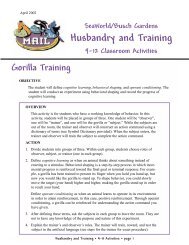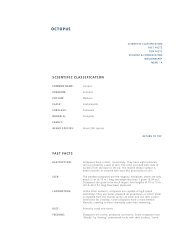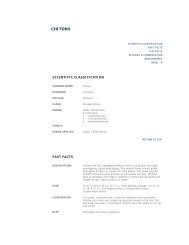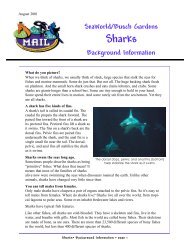Create successful ePaper yourself
Turn your PDF publications into a flip-book with our unique Google optimized e-Paper software.
August 2003<br />
<strong>Bycatch</strong> <strong>Game</strong><br />
OBJECTIVE<br />
ACTION<br />
<strong>Sea</strong><strong>World</strong>/Busch Gardens<br />
Bony Fishes<br />
4-8 Classroom Activities<br />
The student will explore the advantages and disadvantages of different fishing techniques.<br />
1. Explain to students that this is a fishing game. Scatter poker chips over the playing<br />
field; these represent fish. Divide class into predetermined groups (see Material<br />
Preparation) and gather groups together in their sections. Give each group a bucket<br />
and their fishing equipment (rakes or dowels). Explain their fishing method:<br />
Netters use rakes and target red chips: Whole group goes out, holding onto one<br />
another. One person rakes, two people scoop chips into first bucket, the other two<br />
put only red chips into final bucket. All white and blue chips caught must be<br />
dumped outside the play area—they are no longer a resource.<br />
Single-line fishers use dowels and target blue chips: Players take turns going out,<br />
hooking a blue chip, returning, and placing it in the bucket as they hand the fishing<br />
pole off to next player.<br />
Long-line fishers use dowels and target white chips: Whole group goes out, holding<br />
on to one another. One person pulls line through chips, three people remove<br />
chips and place white chips in the last person’s bucket and toss any blue or red<br />
chips outside of the play area—they are no longer a resource.<br />
2. When sections are ready, the teacher calls out “The fish are running.” Student groups<br />
go out and fish. All groups must leave playing field promptly when teacher calls out<br />
“Back to port.” Any groups fishing after the back-to-port call are fishing illegally,<br />
and lose their catch from the last round.<br />
3. Play until all chips are collected off the playing field. At the end of the activity,<br />
gather students to discuss their experience.<br />
BACKGROUND INFORMATION<br />
Humans have gathered fish for food since prehistoric times. Today, fish are a main source<br />
of protein for nearly half the world's population. Through time, new techniques have made<br />
it easier to catch fish. Spears were more successful than bare hands. Hooks were an<br />
improvement over spears. But it was the fishing net that made fishing an economic venture<br />
rather than a way to feed just your own family. Today, some of the fish we eat—like alba-<br />
Bony Fishes • 4-8 Activities • page 1
core—are caught on hook and line, but a great variety of nets are used for catching other<br />
kinds of fish.<br />
Purse seines and drift nets are examples of the modern nets that have improved the fisher's<br />
catch rate. But they've also introduced new problems: the nets catch everything, regardless<br />
of species or size. When the nets are hauled in, fishers try to toss back undersized fish or<br />
those of the wrong kind, called the 'bycatch;' but the majority of nontarget fish die. The<br />
success of one fishery can have negative effects on other species of marine life.<br />
QUESTIONS FOR DISCUSSION<br />
a. What were the advantages of their fishing method? (Nets gather many chips at once;<br />
fishing poles allowed for more selective aim, long lines might be viewed as sort of<br />
the best of both worlds).<br />
b. What were some of the disadvantages of their fishing method? (Nets brought in a lot<br />
of the wrong-colored chips, had to spend a lot of energy to dispose of them, fishing<br />
line could only bring in one chip at a time, long line "hooked" some of the wrong<br />
color chips).<br />
c. Which method is probably used most for gathering schooling fishes? Why?<br />
d. Which method would probably be best to use with a species that doesn't school? Why?<br />
e. Which method had a greater bycatch? Have students discuss how much of the resource<br />
is wasted, and what effect that has on the ecosystem and the future of the fishing industry.<br />
MATERIALS<br />
Per five students:<br />
• garden rake<br />
• wooden dowel<br />
• two-foot string<br />
• four-foot string<br />
• child’s sand pail<br />
• magnetic craft strips<br />
• child’s sand pail<br />
Per class:<br />
• about 35 red, 35 white, and 35 blue poker<br />
chips<br />
• glue<br />
• magnetic craft strips<br />
• playing field<br />
MATERIAL PREPARATION<br />
1. Divide your class into groups of five to<br />
determine how many sets you have. For<br />
example, a class of 30 students will have<br />
6 groups or sets.<br />
2. Evenly (or as close as possible) split the<br />
sets or groups into three sections. For<br />
example, a class of 30 students will<br />
have 6 groups split into 3 sections.<br />
(Each section has two student groups or<br />
sets for a total of 10 students in each<br />
section.). One section will use rakes to<br />
simulate fishing nets, another section<br />
will use single fishing lines, and the<br />
remaining section will use long lines.<br />
3. To make single fishing lines, glue a<br />
small piece of a magnetic strip to the<br />
end of a two-foot long piece of string.<br />
Tie the other end of the string to the<br />
dowel. Make one dowel for each group<br />
in this section.<br />
4. To make long-line pole, glue four small<br />
pieces of magnetic strip to a four-foot<br />
piece of string. Tie the other end of the<br />
string to the dowel. Make one dowel for<br />
each group in this section.<br />
5. Finally, glue a piece of magnetic strip to<br />
one side of both the white and blue<br />
chips.<br />
Bony Fishes • 4-8 Activities • page 2 © 2003 <strong>Sea</strong><strong>World</strong>, Inc.






